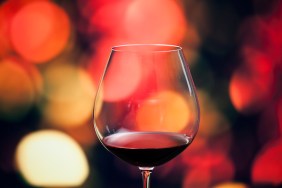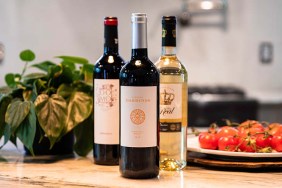You have a date coming over to your apartment tomorrow night. She is hungry for dinner, and you are determined to feed her, as you are a romantic fellow who has learned basic cooking skills and a few fancier dishes for such occasions as this. You know she likes wines. You also like wine. You, however – like so many of your peers – know precious little about wine.
The sad fact remains: When we turn 21, and we’re finally getting out into the large and raucous would of alcohol consumption, we fins ourselves at a loss for actual knowledge. Most young men and women typically stop at the drinks that have funny names (quick hint: anything with a sex term or a cuss word in the name is not a classy or good drink). Either that, or we indulge in the garbage that is merely affordable. In the worst cases, we choose the brightly-colored monstrosities that have enough sugar and corn syrup in it to make you vomit all the earlier in the evening. We haven’t moved too far past the teenage habits of sneaking whatever we can.
CraveOnline is here to help you. Welcome to the first installment of How to Be a Man. A new feature that will instruct you, young men, in the classier ways of life. We will interview the experts who know how to separate the wheat from the chaff. The class from the tacky. The great from the garbage.
This first installment Crave sat down with Lance Montalto, a wine expert who works among the venerable and knowledgeable staff of The Wine House in Los Angeles. Lance was eager to discuss the details of Italian red wines (which is the best wine to go with an Italian meal), and gives you a few terms, things to look for, and – perhaps most importantly – how to beat a red wine hangover.
CraveOnline: I understand there are volumes to know about wine, so let’s start specific. What would a young man need to know about Italian red wines if a date is coming over? What is he serving? What should he pair with it?
Lance Montalto: Food is always part of the equation. Italian food, Italian wine. Half the city is now Italian, which is why Italian sales have gone up, food wise.
There are two major varietals. Italy has 2200 hundred different grape varietals. To put that in context, California has about 200-plus. France has about 500, Spain about 700. Italy has 2200 to 2400 different kinds of grapes. The two most important kinds of varietals, however are: Sangiovese – which is good if you’re doing pastas and meats, if you’re doing a steak – anything Sangiovese-based. Chiantis. Brunellos. Most of your super Tuscans are Sangiovese.
The other major type is Nebbiolo. It’s lighter. It’s very Pinot Noir-ish. More elegant. And it has a broader sense of field. In that: If you’re doing tunas and salmon, roast chicken, if you’re doing turkey and other fowl, up to lamb. Nebbiolos run that broad spectrum. So for heavier, heartier meals, so with Sangiovese. If it’s lighter to middle-to-heavy fare, Nebbiolo.
Of the Nebbiolos… I like a Barolo/Barbaresco. Are you familiar with it? This is perhaps Italy’s most important wine in terms of longevity. So Barolos, Barbarescos, and other Nebbiolo wines.
Which of the two is the less expensive?
They both vary, of course. You can find some good Sangioveses at $8 a bottle! You can find some Brunellos that are up to $500 a bottle. Same thing with Nebbiolo. You can find a decent one at $15, that’s wonderful light and refreshing, to Barolos that are $600 – $700 a bottle. So there’s a broad range.
But if someone walks into a retail shop, or he’s out to dinner and he’s ordered lamb or beef, and she’s getting the fish, Barolo is a good call. Because it’s going to go with both. But if you’re splitting a steak or getting ribs or something, a good Chianti. Or a good Brunello. Brunello’s the wine. Montalcino’s the region. But go 100% Sangiovese.
Those are the basics. That’s where you start with Italian reds. Those two varietals: Sangiovese and Nebbiolo. And with those varietals, there are a lot of wines that encompass them.
The thing I always say about Italian wine is: As great as it marries with Italian food, it’s actually great with a lot of other cuisines from around the world.

Related: The Top-10 Food and Wine Festivals
If one is on a date and he orders a nice wine, is there a way he can share that knowledge without coming across as a snot or a douchebag? What could one do to display that they have made a good wine choice as opposed to a bad one?
That’s always the awkward thing, isn’t it? Let’s take the Brunello di Montalcino as an example. All Italian wines are the Something di Somewhere. A good Sangiovese is from Tuscany – Montalcino is in Tuscany – so if you know you’re getting a Sangiovese, you can just say that it’s a “Tuscan red.” Tuscan reds – and I’m not getting into the history of the area right now! – are meatier and darker grapes. Heavy. In contrast, Barolos and Barbarescos are lighter and more Burgundian. If that translates to them. Most people have heard of French Burgundy wines, and you can use that as a point of comparison without sounding like you’re bragging.
Could you describe the differences in the Tuscan flavors? What would one be tasting for?
Sangioveses: It’s a bigger, richer, fuller-bodied red. It has a lot of body. Favor-wise, you have more red fruits. More cherries. Heavy raspberry tones. A lot of Earth. Stones, things like that. The kinds of things you hear at tobacco shops and cigar boxes. I know that doesn’t sound to appetizing – no one wants to drink a cigar – but it’s more the subtleties on the nose. It’s the aromatics. You get some violets. You get some lavender tones. And this little cigar box from the wood. But it all compiles when you start picking it apart.
But I tell people not to do that at dinners or on dates, because it gets really annoying when you’re sitting at the table. It’s not fun to over-analyze the wine. But that’s Sangiovese. And Brunello is the best. And they’ll range in price on a restaurant menu. From about $40 to the high hundreds.
Chianti – also made of Sangiovese – you’ll find them anywhere on the list from $20 to like $120.
Can you recommend a good Chianti?
A standard you’ll find in a lot of places is Monsanto.
Nothing to do with the chemical agriculture company, right?
It’s funny you should ask! Because yes it does. It has everything to do with them. It’s not a negative now.
So [vintner] Laura Bianchi – her grandfather was Signore Monsanto! He started it in the ’40s or ’50s after the war. He was from this town in Panzano. It has nothing to do with him today, this wine. It’s not connected to GMOs or anything like that. But Laura took over the estate in the ’80s. Her grandfather has passed away. What the company started as, and what the company has turned into is very different. It’s global now. A global nightmare. I get asked about this a lot [laughs].
But it’s the same founder for both. But they’re different companies now. Very different companies.
It’s like the Oneida sex cult and the Oneida silver company.
Exactly! So Laura Bianchi farm organic. All her wines are fantastic. She is sustainable and the wine is, of course, sustainable. So great wines. But as for things that you’re prone to see on lists, you’ll see this on a list for about $40 (although it retails here for about $22).
On the lower end of the price scale is that one right next to you. Badia a Coltibuono. This is a good entry-level Chianti, and you’ll find it on lists for about $25. Brilliant little wine. Well-structured. Well-made. And you’ll see it by the glass. And it’s great! It’s a really good wine if you’re having pastas, or having seafood, or ever roasted chicken. It’s going to pair with a lot of stuff. But it’s on the simple side. If you’re just going down to get pizza, that’s your perfect pizza wine.

Check Out: Tips on Gifting Wine
If one is going out for pizza or Italian food, what’s the worst wine they could order? What’s the big no-no?
Cab. Cab. Anything with dark fruits. Black fruits. Cabernet. Merlot. Syrah. Are poor. Just because they’re black fruits. Chiantis have red fruits. Cherries, raspberries, strawberries. Not that they have those fruits in them, but they have the subtlety of red fruit. As opposed to blueberries and blackberries and black currants. For steak that’s great. If you’re doing robust dishes, that’s great. With braised meats, they’re fantastic. But with pizza? Red sauce? Tomatoes? You need acidity. It just clashes and it’s very unpleasant.
No Cabs. No Merlot. And No Syrah.
This is why Chianti does so well with food. It’s one of those wines that really unpleasant to drink on it’s own because it’s so highly acidic. So they’re really biting. They’ll take the enamel right off your teeth. With food, though – with meat proteins or cheese proteins or fats or red sauces and tomato-based dishes – that’s when they really do it. The acids start binding, so they do well.
Always with food.
You will never see an Italian or a French person or a Spaniard drinking wine without food. In Europe, wine is always food-driven.
That’s why California wines are so popular over here. California wines tend to go very well without food. We come out of this very English set of how you drink: You come home and you have a martini. My grandfather used to come home, light up cigarettes like there was no tomorrow, and just start pouring out vodka. “I’m out for the rest of the night.” Hard-working guy. He was awesome. That notion of coming home and having a glass of something has rotated beyond hard booze. Now it’s wine. The French, the Spanish, the Italians, they come home and they don’t have booze. That’s more of a British/Irish social norm that we have inherited. And we’ve latched onto California wines in that respect.
What would one order without food?
Merlot goes great for that. ‘Cause they’re generally soft. Fleshy. Round. Low tannins. A good California Merlot. Not a European Merlot. California Merlots are just really easy-drinking wines. It’s what they’re perfect for.

If you’ve seen Sideways and you are in a place where you kind of sniff at Merlots, what’s a good alternative.
[rolls eyes and smiles “Oh that movie”] If you’re at an Italian restaurant, Dolcetto. It means “little sweet wine.” If you’re drinking French, Beaujolais. If you’ve ever heard of Beaujolais nouveau. They do fantastic because they’re very light and refreshing. Syrahs too. Not French Syrah, but California and Australian Syrah. Because they tend to be ripe, rounder and fuller. But they’re more accessible.
Here’s the thing about accessibility: There are hard-and-fast rules about wine and wine pairings. But, at the end of the day, drink what you like. I go with the pastas and Chianti ’cause it works! Or Bordeaux and prime rib. It’s one of the great food pairings. But if you don’t like red wines, have Pinot Grigio with prime rib.
What do you want to taste for to identify a quality wine?
Aromatics to begin with. Looking at the wine will only tell you what type of wine it is, and only if you know what the varietal is supposed to look like. If you know Pinot is light, and you look at the wine and it’s light then it’s right. If it’s not, then the restaurant probably added something to it. But for me, it’s aromatics. It’s front, mid, and back-palate. The front is the fruit and all that. The mid-palate… there are a lot of wines out there that I call “donuts.” In the middle, there’s nothing there. It’s hallow. There’s fruit up front and there’s something in the back on the finish, but while it’s in your mouth, there’s nothing there. You get that with cheaper wines.
A good wine will have all three aromatics. It’s not the bite. It’s not the acid. It’s not the tannins. It’s the fruit. You swallow, and you find you’re still tasting the fruit. But it could be coffee tones. It could be tobacco tones. It could be lychee nut. You want those fruits and those flavors running through. When people say they don’t want a strong finish, they’re usually referring to tannins.
Tannins, by the way, or the color of the wine. When you run your tongue over the roof of your mouth, and you feel the gritty, pearly textures, those are tannins.
What is the best way to get rid of a win hangover?
I hit the house, the first thing is two Advil. On the Italians, it’s always the same thing. Two glasses of water for every glass of wine. As you’re drinking, drink water. As you drink water, it dilutes the system. I’ve seen guys who can somehow survive anything. I drank with these guys once, and the next morning I felt like I had been run over, but they’re in full suits rearing to go at 7:30 and 8. I learned that it was the water! Advil in bed, lotta food, lotta water.
Witney Seibold is a contributor to the CraveOnline Film Channel, and co-host of The B-Movies Podcast. You can read his weekly Trolling articles here on Crave, and follow him on “Twitter” at @WitneySeibold, where he is slowly losing his mind.








